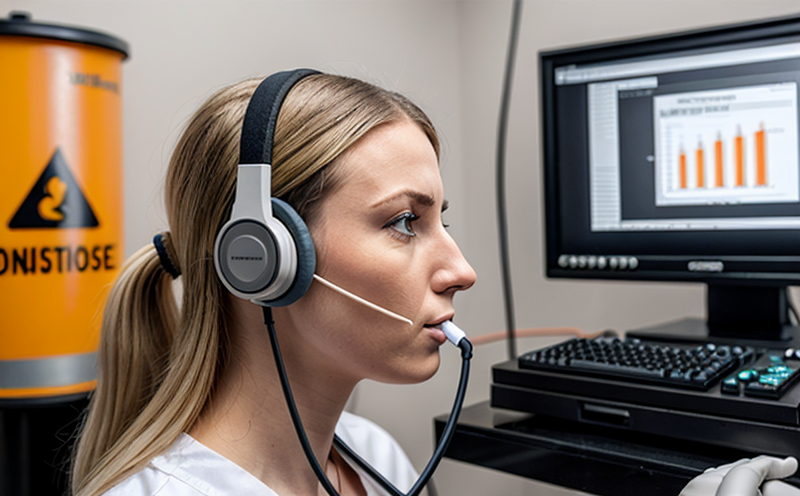ISO 4869-3 Hearing Protector Insertion Loss Testing
The ISO 4869 series of standards provides a comprehensive framework for the testing and evaluation of hearing protection devices (HPDs). Specifically, ISO 4869-3 focuses on determining the insertion loss (IL) of HPDs. Insertion loss is a critical parameter that quantifies the reduction in sound pressure level experienced by an individual wearing the protector compared to when they are not.
This test is essential for ensuring compliance with occupational safety and health regulations, particularly those aimed at protecting workers from excessive noise exposure. By accurately measuring insertion loss, this standard helps manufacturers and users verify the effectiveness of HPDs under various environmental conditions.
The ISO 4869-3 test involves placing the hearing protector on a dummy head or anthropomorphic phantom (DHA) that is designed to simulate human characteristics relevant to sound transmission. The setup typically includes a noise source, microphones, and measurement instruments calibrated according to international standards such as IEC 61252. The test protocol ensures consistent results across different laboratories by specifying precise procedures for specimen preparation, positioning, and data acquisition.
Understanding the insertion loss of HPDs is crucial for several reasons. First, it allows employers to select appropriate protection based on workplace noise levels. Second, it provides manufacturers with valuable feedback on product design and performance optimization. Lastly, it ensures that workers receive adequate protection against hearing damage in noisy environments.
The test procedure outlined in ISO 4869-3 involves several steps:
- Specimen Preparation: The HPD is carefully aligned with the DHA to ensure proper fitting and positioning.
- Noise Source Calibration: The noise source is calibrated using a precision sound level meter conforming to IEC standards.
- Data Collection: Sound pressure levels are measured both with and without the HPD in place. The difference between these two measurements represents the insertion loss.
- Data Analysis: Results are analyzed statistically to ensure reliability and accuracy.
The test results provide valuable insights into the performance of hearing protectors, helping stakeholders make informed decisions about their use. Compliance with this standard ensures that HPDs meet stringent international quality benchmarks, enhancing overall occupational safety and health standards.
Benefits
The ISO 4869-3 hearing protector insertion loss testing offers numerous benefits to various stakeholders:
- Manufacturers: By ensuring that their products meet the strictest international standards, they enhance product quality and gain a competitive edge in the market.
- Employers: Compliance with these tests demonstrates commitment to employee safety and compliance with regulatory requirements.
- Regulatory Bodies: Consistent application of ISO 4869-3 helps standardize testing procedures, ensuring uniformity across different jurisdictions.
- Workers: Reliable data from this test ensures that they receive adequate protection against noise-induced hearing loss in their work environments.
In summary, the benefits extend beyond mere compliance to include enhanced product quality, improved worker safety, and more effective regulatory oversight.
Why Choose This Test
- Regulatory Compliance: Ensures that hearing protectors meet stringent international standards.
- Precision Measurement: Accurate measurement of insertion loss for reliable results.
- Consistent Results: Standardized procedures ensure consistent outcomes across different testing environments.
- Comprehensive Evaluation: Evaluates the effectiveness of hearing protectors in various noise conditions.
- Confidence in Performance: Provides confidence that selected HPDs will adequately protect workers from noise exposure.
The ISO 4869-3 test is a cornerstone for ensuring high-quality, effective hearing protection across industries where noise exposure is a concern.
Use Cases and Application Examples
| Industry Sector | Application Example |
|---|---|
| Aerospace | Evaluating HPDs for pilots during takeoffs and landings. |
| Mining | Testing HPDs in underground mines to protect against rock drilling noise. |
| Manufacturing | Ensuring that workers in high-noise environments receive adequate protection. |
| Construction | Evaluating the effectiveness of HPDs for construction workers operating heavy machinery. |
| Military | Testing HPDs used by soldiers exposed to gunfire and explosions. |
| Hospitality | Ensuring staff working in noisy environments receive appropriate protection. |
| Transportation | Evaluating the noise reduction capabilities of HPDs for train operators. |
The ISO 4869-3 test is widely applicable across these sectors, making it an indispensable tool in protecting workers from harmful noise exposure.





